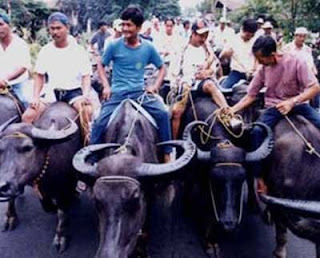The Seville Fair From Spain!

The Feria de Abril de Sevilla, literally Seville April Fair, is held in the Andalusian capital of Seville, Spain. the fair generally begins two weeks after the Semana Santa, or Easter Holy Week.
The fair officially begins at midnight on Monday, and runs for six days, ending on the following Sunday. During past fairs, however, many activities have begun on the Saturday prior to the official opening. Each day the fiesta begins with the parade of carriages and riders, at midday, carrying Seville's leading citizens which make their way to the bullring, La Real Maestranza, where the bullfighters and breeder meet.

Costumes
La Feria of Abril is accompanied by men and women dressed up in their finery, ideally the traditinal "traje corto" (short jacket, tight trousers and boots) for men and the "faralaes" or "trajes de flamenca" (flamenco style dress) for women. The men traditionally wear hats called "cordobes".
 |
The Feria de Abril de Sevilla, literally Seville April Fair, is held in the Andalusian capital of Seville, Spain. the fair generally begins two weeks after the Semana Santa, or Easter Holy Week.
The fair officially begins at midnight on Monday, and runs for six days, ending on the following Sunday. During past fairs, however, many activities have begun on the Saturday prior to the official opening. Each day the fiesta begins with the parade of carriages and riders, at midday, carrying Seville's leading citizens which make their way to the bullring, La Real Maestranza, where the bullfighters and breeder meet.
For the duration of the fair, the fairgrounds and a vast area on the far bank of the Guadalquivir River are totally covered in rows of casetas (individual decorated marquee tents which are temporarily built on the fairground). Some of these csetas belong to the prominent families of Seville, some to groups of friends, clubs, trade associations, or political parties. From around nine at night until six or seven the following morning, at first in the streets and later only within each caseta, you will find crowds partying and dancing "Sevillanas", drinking Jerez sherry, or manzanilla wine, and eating tapas.

History
The Fair dates back to 1847 when it was originally organized as a livestock fair by two coucillors, Jose' Maria Ybarra and Narciso Bonaplata. Queen Isabel II agreed to the proposal, and on April 18th, 1847, the first fair was held at the Prado de San Sebastian, on the outskirts of the city.
It took only one year before an air of festivity began to transform the fair, due mainly to the emergence of the first three casetas, belonging to the Duke and Duchess of Montpensier, the Town Hall , and the Casino of Seville. During the 1920's, the fair reached its peak and became the spectacle that it is today.La Feria of Abril is accompanied by men and women dressed up in their finery, ideally the traditinal "traje corto" (short jacket, tight trousers and boots) for men and the "faralaes" or "trajes de flamenca" (flamenco style dress) for women. The men traditionally wear hats called "cordobes".







Comments
Post a Comment